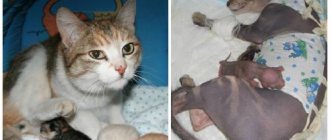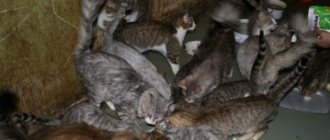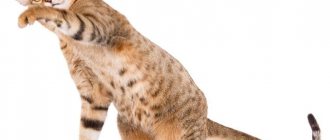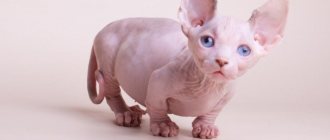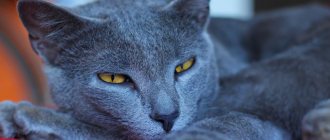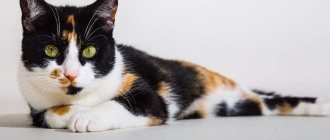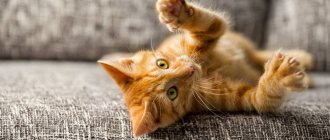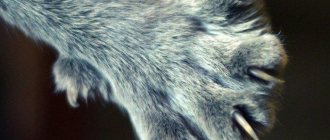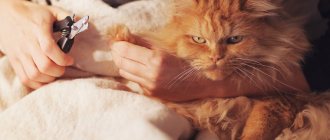The domestic cat is a proud descendant of wild and capricious animals, and claws are an important element of feline life: they help to hunt, defend themselves and mark their territory. The declawing procedure forever relieves the animal owner from hassle in matters of order and safety. In the article we examined in detail all the details of the operation. We will tell you why a cat is declawed, how the operation is performed, we will note the main points of caring for a cat after surgery, and we will outline possible complications.
What is “onychaetcomia”?
Onychectomy or soft paw surgery is an increasingly popular procedure, along with sterilization, as an alternative to conventional nail trimming for cats.
During onychectomy, the animal is completely deprived of its claws.
This surgery is performed by a veterinarian under general anesthesia. The doctor amputates the end whole phalanx of the fingers along with the claws. The procedure can be carried out through:
– removal of the nail plate with a scalpel and scissors;
– declawing using laser surgery;
The procedure is carried out under the supervision of a specialist
The operation is performed in a clinic, but there is also a home visit. In order to minimize pain, the animal is injected with an anesthetic, and additional medication may be given orally. The rehabilitation period can take a week and during this time the animal needs careful care.
Precautionary measures
To keep your four-legged friend's claws always in order, follow some simple rules.
- Check your claws regularly. Each cat's hair grows at a different rate, but on average they need trimming once every three weeks. If you notice that your pet is walking around with a broken nail, trim the latter to a safe shape.
- If your cat’s claws often peel and break, it’s worth reviewing and diversifying its diet. You may need to start giving your pet vitamins after consulting with your veterinarian.
- Cover dangerous areas in the house, such as the bathroom and toilet, where your cat can easily get hurt by climbing on smooth or slippery surfaces.
- Buy your pet a quality scratching post and teach him to use it regularly.
- Pay special attention to older cats. Their claws can sometimes be pressed into the pads until they bleed. Check your pet's nails every week and trim the tips if necessary. This is much easier than letting them grow over and then seeking help from a doctor.
Photo:
The meaning of claws in a cat’s life: “basic instinct”
Domestic cats and cats living their lives in apartment conditions are not quite the same as their wild ancestors. It is enough to turn to a simple example and draw an analogy with a private house: in the latter case, many owners allow the animal to spend time outside, and this significantly changes the essence of the issue.
What is the difference? Scratching is not just part of basic nail care. In nature, a domestic animal realizes its instincts: it hunts, snatches prey, climbs trees and, most importantly, marks its territory with the help of its claws, leaving the secretion of glands on the paw pads on the surface, thereby showing “who’s boss.”
All this allows the animal to maintain psychological balance and feel comfortable in the territory.
One of the strongest cat instincts is to mark its territory.
Alternatives
The overwhelming majority of cat lovers, felinologists and veterinarians are of the opinion that since cats are born with claws, they should remain with them. Some people believe that it is unnatural to remove a cat's claws to please the owner.
There are many arguments in support of this opinion. For example, the pain and suffering that pets go through, complications after surgery. Therefore, cat lovers and veterinarians look at this procedure as a last resort. But if owners want to give up their cats, euthanize them, or kick them outside due to the damage caused by claws, then cat onychectomy is an option to prevent this.
There are alternatives to declawing. One of them is teaching your pet to sharpen its claws in a designated place (on a scratching post or a specially covered board with hard fabric). This is a very effective method, but less successful when living with older cats.
There are also vinyl, rubber and silicone cat claw caps (set of 20). The service life of the caps is 1.5-2 months. They are put on using surgical glue, and cats usually get used to them within a day or two. But the glue must be applied correctly to the trimmed claws.
Owners sometimes glue several fingers together when they try to do this procedure themselves. Therefore, entrust the labeling of the caps to a professional who can also select the correct size.
Important! If your cat goes outside, the lifespan of the caps will be significantly reduced.
Trimming claws is also an alternative to removing them. If you do this weekly, it will solve the problem of people scratching, but it will not stop your cat from damaging the furniture. In addition, she will want to sharpen her trimmed claws more often.
Reasons for declawing cats
Recently, onychectomy has gained popularity among owners of absolutely healthy cats, ceasing to be an exclusively therapeutic measure.
The most common reason for the decision to remove claws is the animal's disobedience and hyperactivity, which results in significant damage to property. The decoration and furniture take on an unsightly appearance, requiring large financial investments and repairs.
Claws help a cat quickly adapt to its surroundings
Unfortunately, another reason lies in the individuality of each pet: some animals can show both innate and acquired aggression, scratching guests and even the owners themselves. Sometimes this happens unexpectedly, and owners cannot understand for a long time the reasons for the sudden change in the animal’s behavior. The situation becomes much more complicated if there are children in the family, who will always attract the pet’s attention with their movements.
Considering the situation irreparable, animal owners turn to the veterinarian.
Removing urine odor from clothes, shoes and home textiles
Cats can mark not only floors and carpets, but also other household items. Some mustachioed robbers have a special “love” for the clothes and shoes of their masters. If a cat gets into the habit of marking its territory, then smelly tracks can be found anywhere. To completely rid household items of unpleasant odors, use:
- washing with laundry soap;
- a mixture of lemon juice, water and acetic acid, which is perfect for removing old stains;
- a mixture of hydrogen peroxide and baking soda for cleaning outerwear;
- alcohol or vodka diluted with water for cleaning fur coats and other fur products.
As for shoes, in which, for reasons unknown to people, cats like to leave unpleasant puddles, it is recommended to wash old stains from dried cat urine inside with a solution of potassium permanganate, and outside with laundry soap, and then wipe with lemon juice. To remove fresh traces of cat urine, just one laundry soap is enough.
When is declawing necessary?
Initially, onychectomy appeared for completely different purposes and was justified by serious medical indications.
A serious reason for declawing is:
– a complex chronic disease in a cat (epilepsy: the animal can tear out tufts of fur with its claws and injure itself);
– if the cat suffers from an infectious disease that is transmitted by scratching;
– deformation of the phalanges, which causes the animal severe pain when moving;
– if an adult animal began to show unreasonable aggression and the owners were unable to establish the reason for such behavior;
– the owner or family members have complex immunological diseases and blood diseases (for example: blood incoagulability, diabetes);
Declawing can have unpredictable effects on your pet.
IMPORTANT: other causes have many alternatives and do not require radical intervention!
Risk factors
There are several factors, in addition to the diseases listed above, that can lead to tooth extraction.
Firstly, cats with an upturned nose and a short muzzle develop a certain jaw structure at birth, which may lead to the need to remove teeth.
Secondly, poor hygiene and, as a consequence, the accumulation of large amounts of plaque and tartar also lead to further tooth extraction.
Read more about tartar: Removing tartar from a cat
Thirdly, these are injuries accidentally received by the animal, which led to deformation of the jaw and skull. Most often, it is this disease that contributes to the inevitable removal of teeth. Therefore, it is very important to ensure that the cat does not fall or get into trouble with other animals.
And fourthly, these are milk teeth that did not fall out on time. In order to avoid these negative factors, contact your veterinarian to examine your cat's oral cavity once every six months.
|
At what age can a cat be declawed?
The age of onychectomy is the most common question that worries owners who have decided to undergo surgery. Is it possible to have surgery at an early age?
You should refrain from performing surgery on a kitten: their claws do no harm. The body is just developing and it is not worth exposing the animal to serious stress. A kitten's young age is the right time to take steps to develop positive habits in your pet's character.
Nail trimming is a safe alternative for a healthy cat
The operation to remove claws is carried out after 7 months: the cardiovascular system has already become stronger, and the animal adapts more easily to the consequences of walking without claws. All medical interventions are much easier to tolerate at a young age.
How to feed a cat after tooth extraction
After the tooth extraction procedure, the cat regains its vitality. And there is a high probability of its weakening. In addition, the animal may vomit, and its appetite often worsens. Therefore, you need to create comfortable conditions for your pet.
He will be able to start eating only after he has completely recovered from the state of anesthesia. And for the first time, every half hour, you need to moisten the cat’s oral cavity with a small amount of water. To relieve her of dryness and thirst. A pipette is best suited for this. The main thing is that the pet does not drink from the bowl on its own. This is fraught with serious consequences in the form of water entering the respiratory tract. After complete recovery from anesthesia, all food must be blended in a blender before serving until the inflamed gums have healed. Food should be semi-liquid and semi-porridge. It is also very important to maintain an optimal balance of vitamins in the animal’s body.
Read about vitamins: What vitamins does a cat need?
How is declawing surgery performed?
The four-legged patient is prescribed a number of diagnostic procedures necessary to assess the risks to his life that may be caused by the anesthesia used during the operation.
Mandatory diagnostics of your pet’s health will protect you from unexpected complications.
After a complete examination, the doctor determines the possibility of surgery and sets a time for the procedure. Some owners are inclined to carry out onychectomy at home, hoping that the animal will better tolerate the operation in its own home. It is much safer if the intervention is carried out in a clinic in case of unforeseen circumstances that may require a quick response in a hospital setting.
The traditional method (scalpel, surgical scissors) is strict adherence to the “fasting regime” 8-12 hours before the start of manipulations and limiting any stress. Next, the doctor administers an anesthetic drug, after which the animal falls asleep. The surgeon removes the claws and sutures the affected surface; to relieve pain, the area is treated with an anesthetic and the paw is bandaged. A special “Elizabethan” collar is placed on the cat’s neck, which limits access to the limb.
The use of a laser repeats the scenario of the previous method, with the exception of excision of tissue with a high-intensity beam and is distinguished by the “purity” of the declawing procedure. Blood loss with this method of declawing is minimal.
Positive aspects of onychectomy:
– if there are serious medical indications, the animal will be relieved of discomfort and pain;
– the pet will not be a threat to your property;
– an aggressive disposition will not leave scratches on guests and the owner;
– it will be possible to allow children near the wayward pet and not be afraid of unexpected consequences;
The absence of claws eliminates the risk of injury when playing with an animal
Disadvantages of onychectomy:
– negative reaction to anesthesia;
– improper pruning: in this case, the phalanx may grow and the claw will grow inward rather than outward;
– onychectomy can greatly affect the character of the animal, making it passive or even more aggressive;
– declawing comes with many risks (tissue infection, poor mobility, etc.);
– during the rehabilitation period the animal experiences severe pain;
– during the recovery period, the cat will not be able to move independently;
– there is a possibility of large blood loss;
– development of arthritis as a consequence of further emphasis only on the pads of the paws;
Declawing leaves an animal defenseless
Loss of smell
A person smells through receptors. Molecules of substances carrying aroma enter the receptors, these waves are transmitted along the nerve endings to the brain, where this impulse is processed. Most often, loss of smell occurs in men, much less often in women. With age, the risk increases, and you need to be more careful about your body.
There are different types of loss of smell:
- Hyposmia is an extremely poor perception of smells. Also, with hyposmia, there is an incomplete loss of smell, i.e. only for certain smells.
- Hyperosmia is, on the contrary, excessive sensitivity to odors.
- Cacosmia - perception in this case is turned upside down. Attractive smells seem disgusting.
- Anosmia is the complete loss of olfactory processes. It is formed due to colds, and in some cases even after a stroke.
Loss of smell can occur from birth, due to the fact that the respiratory organs have not had time to form properly. You can also acquire anosmia during your life.
Causes of loss of smell
During the loss of smell, the receptors will not respond to stimuli. The brain does not receive signals and does not distinguish smells. If the problem is in the central nervous system, then the receptors, on the contrary, send impulses to the brain, but the brain does not perceive them. And sometimes it may be that the receptors in the nose recognize and send odors to the brain, but along the way they are blocked.
ARVI and COVID-19
Loss of smell can be a consequence of a common cold, flu or acute respiratory viral infection. In this case, swelling of the mucous membrane occurs, which disrupts not only the breathing process, but also deprives the receptors of their functions - transmitting impulses to the brain.
Not long ago, doctors found out that loss of smell is, in most cases, also a symptom of coronavirus. It appears in 80% of cases on about 3–5 days. Moreover, during this period the person may not experience any other symptoms. It is known that the nasal mucosa is the first to encounter viruses and bacteria, and the immune system begins to work from the nose to destroy as many viral agents as possible. Perhaps damage to the receptors and cells of the mucous membrane occurs precisely because of the “smart” attack of the virus in order to break the defense at the attack stage and easily penetrate the body.
Another opinion is that the sense of smell disappears due to the body’s protective reaction to the virus; the receptors sacrifice themselves to prevent the infection from spreading. The sense of smell returns approximately 2 weeks after complete healing. But there are rare cases when the return is delayed and the sense of smell is fully restored within several months.
According to statistics, in most cases this symptom indicates that the disease will not develop into a particularly acute form with serious consequences. Most often, anosmia develops immediately after the incubation period, 3-4 days after the viral agents have entered the body, but before the appearance of other symptoms - sore throat, cough, fever, rash and chest congestion, weakness and fever.
According to another version, with covid, olfactory receptors are damaged at the level of the nervous system, when the transmission of impulses from the receptors to the brain and back is blocked by viral agents. But why this happens and how the virus acts in the body of a particular person is an area that has not been sufficiently studied.
That is why sleeping pills and sedatives are often prescribed in doctors’ protocols. To support the nervous system that is being attacked.
Also, we can assume that in mild, moderate and severe forms of the disease without critical complications, the return of the sense of smell with proper treatment of coronavirus indicates that the virus is receding, even if other symptoms are partially preserved.
Parkinson's disease, Alzheimer's disease
Loss of smell in such diseases is the most striking symptom. Sometimes it can become the very first and earliest sign of impending irreversible disorders in the brain. Thus, scientists can determine the risk of disease for a person by how he is able to recognize, remember and remember smells.
In this case, we have to say that the loss of smell is exclusively neurological in nature. Atrophic changes in the cerebral cortex, characteristic of these diseases, affect the central part of the olfactory analyzer. According to MRI, degeneration processes affect the primary olfactory cortex, hippocampus, thalamus and hypothalamus. Which inevitably leads not only to disturbances in coordination activity, but also to memory loss and impaired sense of smell.
Other causes of loss of smell
- Allergy. If a person is susceptible to allergic reactions to the smells of flowers or something else, his nasal cavity may become inflamed.
- Injuries. If the nose or brain is injured, the sense of smell may disappear immediately.
- Age. The older a person gets, the processes in his body slow down. This happens with the membranes of the nose. Older people are more likely to experience dryness and atrophy of the nasal mucosa.
- Tumor. If a benign tumor is found, it is removed and the sense of smell gradually returns.
- Polyps. New growths in the nose can interfere with olfactory processes.
- Smoking. Nicotine destroys the nerve endings in the nose, this happens gradually, but can lead to a complete loss of smell.
- Neurosis. Loss of smell can be caused by long-term emotional problems or a lot of stress.
- Burns. Toxic vapors, when inhaled, can burn the nasal mucosa or lubrication with alcohol-containing liquids.
- Incorrect structure of the nasal cavity.
- Lack of vitamins (vitamin A) or other substances in the body.
Consequences of loss of smell
Problems in the perception of smells are a big problem that has a great impact on the entire body. Bright and juicy aromas of food trigger the digestive system and stimulate the secretion of gastric juice. If a person cannot smell the food he eats, the gastrointestinal tract will also suffer.
If viruses or harmful substances enter the body through the nose, a defensive reaction is provoked, for example, sneezing. If the receptors do not awaken a defensive reaction when the sense of smell is lost, then harmful substances will continue to freely penetrate deep into the body, causing even more damage.
Rehabilitation period
The recovery period depends on the quality of the work performed, the professionalism of the veterinarian and the cat’s reaction to the operation.
A high-quality procedure is the key to a quick recovery
Immediately after the procedure, the cat will sleep: do not be alarmed, the animal may pee under itself and this is a normal reaction to anesthesia.
For the first few days, your pet will not be able to walk: he will be bothered by pain in his paws, joints and back. Use an Elizabethan collar and do not allow your pet to touch the bandages. Every day it is necessary to treat the seams and make sure that the cat does not lick them. Walking outside is completely excluded during this period: there is a high probability of infection of the affected tissues.
IMPORTANT: place the tray, bowl and bed as close to each other as possible, thereby reducing the distances your pet will have to travel!
Five options for effective folk remedies
People have been keeping cats since time immemorial and therefore have long been taught to deal with the unpleasant odor that pets leave when marking their territory. Traces of this will help eliminate:
- Solution with laundry soap. To prepare it, pre-cut soap must be poured with boiling water. Simply foam it up, apply it to the smelly stain and wait about an hour, then rinse thoroughly.
- Acetic acid. Blot the mark with dry wipes, apply a mixture of vinegar and water to the remaining mark, leave for 30-40 minutes and rinse.
- Lemon. Cats do not like the natural citrus aroma, so lemon will be a sure way to deal with the tricks of your pets. Wash the smelly stain with a solution of laundry soap, and then squeeze out the juice from the lemon, dilute it with water and apply to the mark.
- Iodine solution. To prepare it, add 20 drops of iodine to a liter of water and soak the resulting solution on traces of cat tricks, the unpleasant odor will be eliminated.
- Baking soda and hydrogen peroxide. This home remedy removes stink marks quickly and efficiently. Fill the detected stain with dry soda and let it dry, while in the meantime prepare a solution of water and hydrogen peroxide at a ratio of 1:1, add 2-3 drops of dishwashing detergent to it, stir thoroughly, pour on top of the soda, wait 20 minutes and wash it off.
The above folk remedies will help you eliminate the smell of cat marks and puddles from expensive carpets, rugs and other surfaces that your pet has used for its “criminal” purposes.
Consequences, risks and complications
The psychological consequences can be unpredictable: adapting to a new lifestyle and experiencing severe stress, the animal can become irritable, withdrawn, and aggressive. Having lost a vital organ, a pet may perceive this as a danger and begin to avoid people. The situation is fraught with problems with going to the litter box: the cat may lose interest in the box due to the inability to “bury” the filler.
Possible physical effects, risks and complications include:
– prolonged and severe pain, inability and discomfort;
– deterioration of condition after anesthesia;
– violation of coordination and functions of the vestibular apparatus: the center of gravity shifts to the entire paw;
– osteomyelitis: inflammatory infectious disease of the bones;
– curvature of the spine, joint diseases;
– risk of developing an inflammatory infectious process;
Problems with the tray
Cats instinctively avoid repeating the same actions that have caused them noticeable pain in the past... but sometimes they misinterpret the concept of pain.
Has your cat ever stopped using the litter box just because she got a painful urinary tract infection? She attributed the stabbing pain to being in the litter box rather than to an infection. And even after the infection is all over, it will be quite difficult to persuade her to return to the tray. The same can be said for cats that have been declawed. Many declawed cats experience severe pain and discomfort when digging with their paws or standing on the litter box, and training them back to the litter box can be challenging, even if past wounds have healed.
Operation price
If you decide to have an onychectomy, you should not save money. You should entrust the operation to a highly qualified specialist and a veterinary clinic, where your pet will be provided with proper attention.
Entrust the procedure to a highly qualified veterinarian, find out about the experience of performing similar operations
The price for the service is 50-70 dollars. Laser declawing is performed in few clinics and costs approximately $150.
Technique: main points
The actual removal of the bone process is carried out using special tweezers.
After thorough preparatory procedures for all teeth, the animal’s oral cavity is washed with an antiseptic. The yawner is then inserted and the tongue is removed manually. The gums and mouth are lubricated with iodine, then an incision is made with a medical scalpel, after which the diseased tooth is sharply loosened in different directions with forceps and pulled out. Canines and molars are the most difficult to remove. Bleeding often occurs during surgery but stops using conventional methods. To do their work, dentists use articulated forceps, they grab the tooth root, shake it with smooth movements and, when the hinge rests on a healthy tooth nearby, press the handle of the instrument towards the opposite jaw. After this, the affected incisor is easily removed from the oral cavity.
There are cases when the extreme molar does not lend itself to such a procedure and must be knocked out. This is the most difficult dental surgery for cats. To carry it out, trepanation of the jaw of the upper sinus is performed. A round chisel is inserted through the resulting hole and, with short, gentle blows of a special hammer, the diseased tooth is knocked out from the alveolus, only after which is it possible to remove it with forceps. After the procedure, the oral cavity is treated with a solution of potassium permanganate and water, always maintaining a ratio of 1:500, for which sterile swabs and clamps are used.
The veterinarian offers high-quality dental extraction services for cats and also provides assistance to owners with pet oral care.
Pros and cons of onychectomy
The only advantage that the owner of a cat that has undergone execution can feel is that the pet gets rid of a bad habit once and for all.
There are many more disadvantages:
- expensive operation;
- long-term rehabilitation and restoration of health after surgery, which, by the way, also costs a lot of money;
- forever lost health of the pet;
- psychological trauma and a radical change in the cat’s character, which not every pet lover will like;
- the cat’s absolute defenselessness against the dangers of the outside world.
Using a scratching post
Using a scratching post will help solve the problem. To accustom your cat to it, every time you try to scratch the furniture, tell the animal “No!” Using a strict intonation. Then take your pet to the scratching post, place his paws on the equipment and make several characteristic movements with them. Valerian or catnip will help to accustom your cat to the scratching post. But if you put a blanket with a strong smell of soap on the furniture, the animal will lose the desire to sharpen its claws.
Video: option for making a simple scratching post
Consequences related to the musculoskeletal system
The cat has passed the post-operative problems, and it would seem that a joyful, carefree, familiar life awaits ahead. No such luck! Changing the structure of the paw leads to new problems:
- arthritis due to changes in foot placement, when the main emphasis shifts from the toes to the ball of the foot;
- atrophy of the muscles of the back and limbs;
- change in posture;
- loss of balance;
- persistent lameness;
- frequent injuries due to loss of dexterity and the ability to cling to surfaces in unexpected situations.
Carrying out the procedure
The operation should only be performed by a qualified doctor
The animal is under general anesthesia during the procedure. The operation is quite complex and must be performed by a qualified specialist. The doctor uses a scalpel to remove the first phalanges of the fingers.
The operation is primarily performed on the front legs, but at the owner’s request it can also be performed on the hind legs. If the procedure is performed correctly, the cat will be able to stand on its paws the next day. The lameness will disappear in 5–7 days.
Postoperative complications
Not a single operation leaves its mark on a living organism, both in terms of health and psychological state. It’s one thing when they decide to do it in order to save the life of an animal, it’s another thing if the reason is the whim of the cat owner.
Onychectomy is a rather risky event that entails a number of troubles:
- anesthesia is harmful; deaths from it due to incorrect dosage or as a result of intolerance to components are not so rare;
- antibiotic therapy is a prerequisite to prevent the development of a second infection; at the same time, there is a possibility of getting problems with the liver, stomach, and as a bonus, dysbacteriosis with all the ensuing consequences from the use of antibiotics;
- prolonged bleeding followed by anemia;
- inflammation of the deep layers of the skin (abscess, phlegmon), spreading to the bone;
- severe pain due to the affected nerve as a result of an ineptly performed operation;
- the process of regeneration of the claw inside the foot is possible, which means a repeat operation is not far off.
